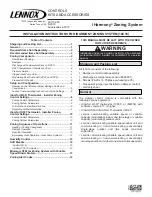
11
|
Troubleshooting
Installer and user reference guide
37
FXDA10~63A2VEB
VRV system air conditioner
4P599621-1A – 2020.10
11.1.2 Symptom: White mist comes out of a unit (Indoor unit)
▪
When humidity is high during cooling operation (in oily and dusty places). If the
interior of an indoor unit is extremely contaminated, the temperature
distribution inside a room becomes uneven. It is necessary to clean the interior
of the indoor unit. Ask your dealer for details on cleaning the unit. This operation
requires a qualified service person.
▪
When the air conditioner is changed over to heating operation after defrost
operation. Moisture generated by defrost becomes steam and exits.
11.1.3 Symptom: White mist comes out of a unit (Indoor unit, outdoor unit)
When the system is changed over to heating operation after defrost operation.
Moisture generated by defrost becomes steam and is exhausted.
11.1.4 Symptom: The user interface reads "U4" or "U5" and stops, but then restarts after a few
minutes
This is because the user interface is intercepting noise from electric appliances
other than the air conditioner. The noise prevents communication between the
units, causing them to stop. Operation automatically restarts when the noise
ceases.
11.1.5 Symptom: Noise of air conditioners (Indoor unit)
▪
A "zeen" sound is heard immediately after the power supply is turned on. The
electronic expansion valve inside an indoor unit starts working and makes the
noise. Its volume will reduce in about one minute.
▪
A continuous low "shah" sound is heard when the system is in cooling operation
or at a stop. When the drain pump is in operation, this noise is heard.
▪
A "pishi-pishi" squeaking sound is heard when the system stops after heating
operation. Expansion and contraction of plastic parts caused by temperature
change make this noise.
11.1.6 Symptom: Noise of air conditioners (Indoor unit, outdoor unit)
▪
A continuous low hissing sound is heard when the system is in cooling or defrost
operation. This is the sound of refrigerant gas flowing through both indoor and
outdoor units.
▪
A hissing sound which is heard at the start or immediately after stopping
operation or defrost operation. This is the noise of refrigerant caused by flow
stop or flow change.
11.1.7 Symptom: Dust comes out of the unit
When the unit is used for the first time in a long time. This is because dust has
gotten into the unit.
11.1.8 Symptom: The units can give off odours
The unit can absorb the smell of rooms, furniture, cigarettes, etc., and then emit it
again.
















































